Per-Arne Andersen
A Comparative Study of Feature Selection in Tsetlin Machines
Aug 09, 2025Abstract:Feature Selection (FS) is crucial for improving model interpretability, reducing complexity, and sometimes for enhancing accuracy. The recently introduced Tsetlin machine (TM) offers interpretable clause-based learning, but lacks established tools for estimating feature importance. In this paper, we adapt and evaluate a range of FS techniques for TMs, including classical filter and embedded methods as well as post-hoc explanation methods originally developed for neural networks (e.g., SHAP and LIME) and a novel family of embedded scorers derived from TM clause weights and Tsetlin automaton (TA) states. We benchmark all methods across 12 datasets, using evaluation protocols, like Remove and Retrain (ROAR) strategy and Remove and Debias (ROAD), to assess causal impact. Our results show that TM-internal scorers not only perform competitively but also exploit the interpretability of clauses to reveal interacting feature patterns. Simpler TM-specific scorers achieve similar accuracy retention at a fraction of the computational cost. This study establishes the first comprehensive baseline for FS in TM and paves the way for developing specialized TM-specific interpretability techniques.
A New HOPE: Domain-agnostic Automatic Evaluation of Text Chunking
May 04, 2025Abstract:Document chunking fundamentally impacts Retrieval-Augmented Generation (RAG) by determining how source materials are segmented before indexing. Despite evidence that Large Language Models (LLMs) are sensitive to the layout and structure of retrieved data, there is currently no framework to analyze the impact of different chunking methods. In this paper, we introduce a novel methodology that defines essential characteristics of the chunking process at three levels: intrinsic passage properties, extrinsic passage properties, and passages-document coherence. We propose HOPE (Holistic Passage Evaluation), a domain-agnostic, automatic evaluation metric that quantifies and aggregates these characteristics. Our empirical evaluations across seven domains demonstrate that the HOPE metric correlates significantly (p > 0.13) with various RAG performance indicators, revealing contrasts between the importance of extrinsic and intrinsic properties of passages. Semantic independence between passages proves essential for system performance with a performance gain of up to 56.2% in factual correctness and 21.1% in answer correctness. On the contrary, traditional assumptions about maintaining concept unity within passages show minimal impact. These findings provide actionable insights for optimizing chunking strategies, thus improving RAG system design to produce more factually correct responses.
Exploring Effects of Hyperdimensional Vectors for Tsetlin Machines
Jun 04, 2024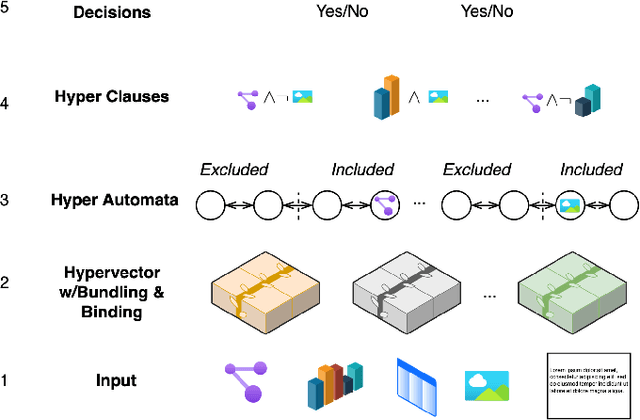
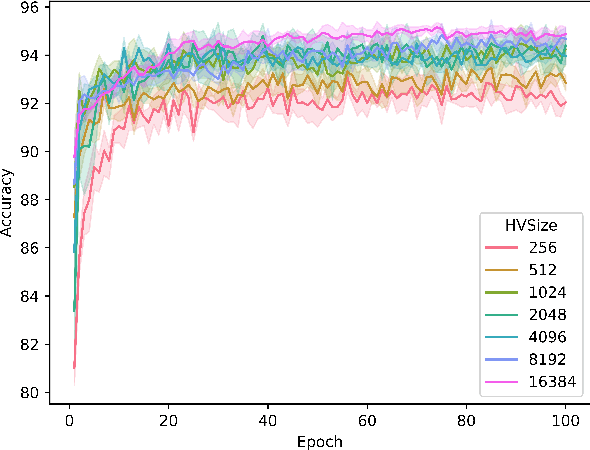
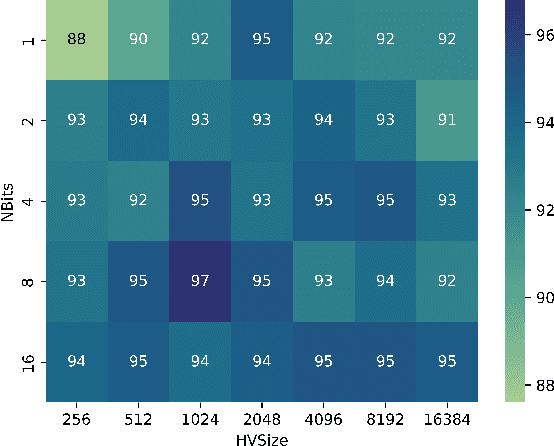
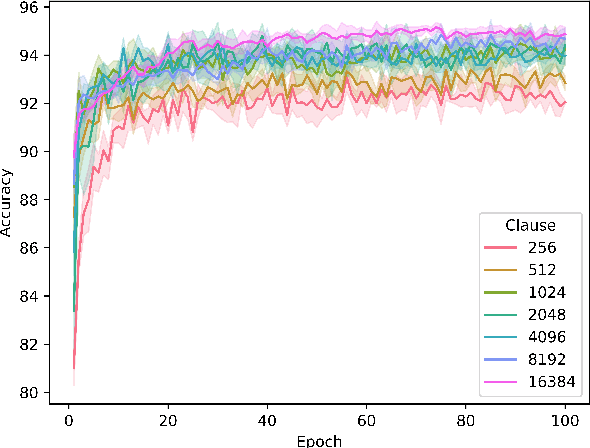
Abstract:Tsetlin machines (TMs) have been successful in several application domains, operating with high efficiency on Boolean representations of the input data. However, Booleanizing complex data structures such as sequences, graphs, images, signal spectra, chemical compounds, and natural language is not trivial. In this paper, we propose a hypervector (HV) based method for expressing arbitrarily large sets of concepts associated with any input data. Using a hyperdimensional space to build vectors drastically expands the capacity and flexibility of the TM. We demonstrate how images, chemical compounds, and natural language text are encoded according to the proposed method, and how the resulting HV-powered TM can achieve significantly higher accuracy and faster learning on well-known benchmarks. Our results open up a new research direction for TMs, namely how to expand and exploit the benefits of operating in hyperspace, including new booleanization strategies, optimization of TM inference and learning, as well as new TM applications.
Contracting Tsetlin Machine with Absorbing Automata
Oct 17, 2023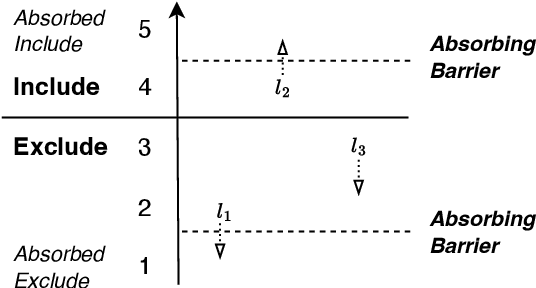
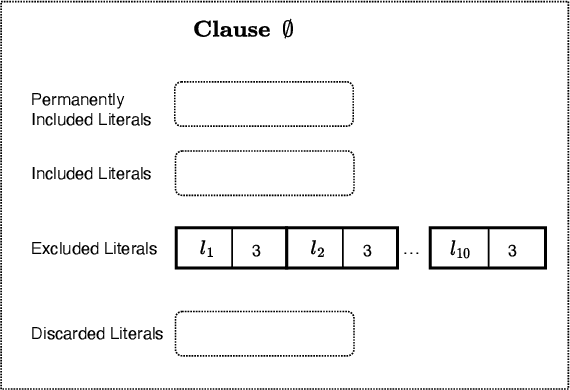
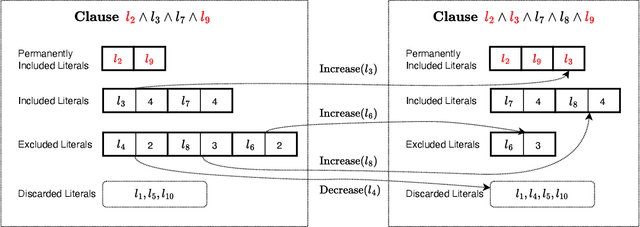
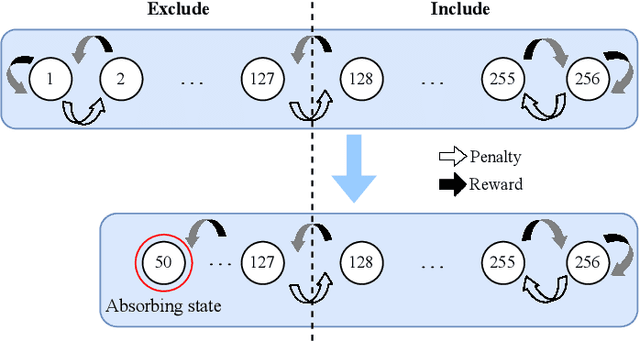
Abstract:In this paper, we introduce a sparse Tsetlin Machine (TM) with absorbing Tsetlin Automata (TA) states. In brief, the TA of each clause literal has both an absorbing Exclude- and an absorbing Include state, making the learning scheme absorbing instead of ergodic. When a TA reaches an absorbing state, it will never leave that state again. If the absorbing state is an Exclude state, both the automaton and the literal can be removed from further consideration. The literal will as a result never participates in that clause. If the absorbing state is an Include state, on the other hand, the literal is stored as a permanent part of the clause while the TA is discarded. A novel sparse data structure supports these updates by means of three action lists: Absorbed Include, Include, and Exclude. By updating these lists, the TM gets smaller and smaller as the literals and their TA withdraw. In this manner, the computation accelerates during learning, leading to faster learning and less energy consumption.
Generalized Convergence Analysis of Tsetlin Machines: A Probabilistic Approach to Concept Learning
Oct 03, 2023

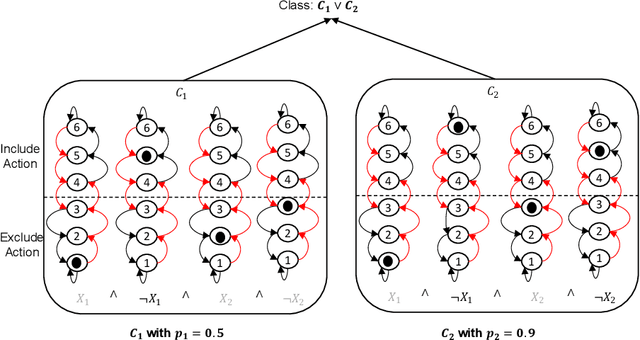
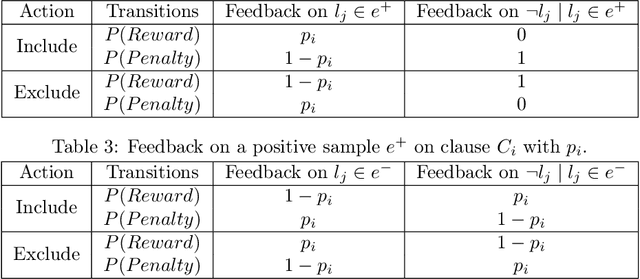
Abstract:Tsetlin Machines (TMs) have garnered increasing interest for their ability to learn concepts via propositional formulas and their proven efficiency across various application domains. Despite this, the convergence proof for the TMs, particularly for the AND operator (\emph{conjunction} of literals), in the generalized case (inputs greater than two bits) remains an open problem. This paper aims to fill this gap by presenting a comprehensive convergence analysis of Tsetlin automaton-based Machine Learning algorithms. We introduce a novel framework, referred to as Probabilistic Concept Learning (PCL), which simplifies the TM structure while incorporating dedicated feedback mechanisms and dedicated inclusion/exclusion probabilities for literals. Given $n$ features, PCL aims to learn a set of conjunction clauses $C_i$ each associated with a distinct inclusion probability $p_i$. Most importantly, we establish a theoretical proof confirming that, for any clause $C_k$, PCL converges to a conjunction of literals when $0.5<p_k<1$. This result serves as a stepping stone for future research on the convergence properties of Tsetlin automaton-based learning algorithms. Our findings not only contribute to the theoretical understanding of Tsetlin Machines but also have implications for their practical application, potentially leading to more robust and interpretable machine learning models.
Learning Minimalistic Tsetlin Machine Clauses with Markov Boundary-Guided Pruning
Sep 12, 2023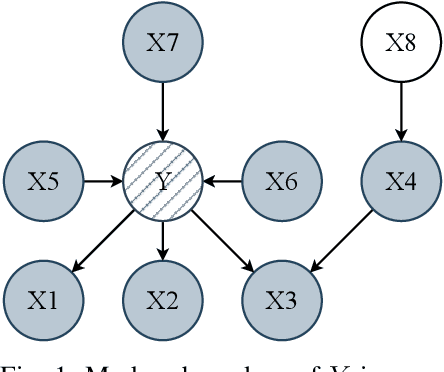


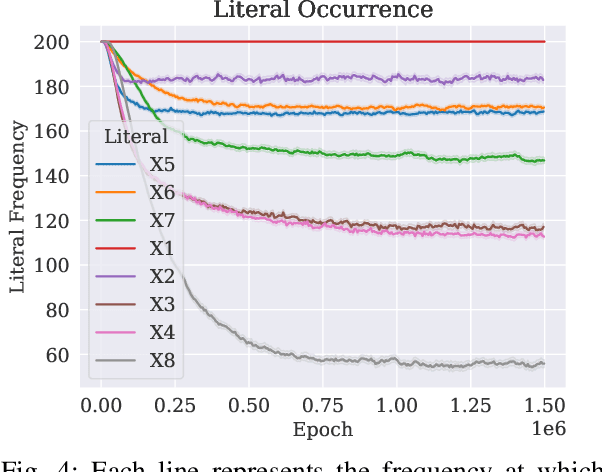
Abstract:A set of variables is the Markov blanket of a random variable if it contains all the information needed for predicting the variable. If the blanket cannot be reduced without losing useful information, it is called a Markov boundary. Identifying the Markov boundary of a random variable is advantageous because all variables outside the boundary are superfluous. Hence, the Markov boundary provides an optimal feature set. However, learning the Markov boundary from data is challenging for two reasons. If one or more variables are removed from the Markov boundary, variables outside the boundary may start providing information. Conversely, variables within the boundary may stop providing information. The true role of each candidate variable is only manifesting when the Markov boundary has been identified. In this paper, we propose a new Tsetlin Machine (TM) feedback scheme that supplements Type I and Type II feedback. The scheme introduces a novel Finite State Automaton - a Context-Specific Independence Automaton. The automaton learns which features are outside the Markov boundary of the target, allowing them to be pruned from the TM during learning. We investigate the new scheme empirically, showing how it is capable of exploiting context-specific independence to find Markov boundaries. Further, we provide a theoretical analysis of convergence. Our approach thus connects the field of Bayesian networks (BN) with TMs, potentially opening up for synergies when it comes to inference and learning, including TM-produced Bayesian knowledge bases and TM-based Bayesian inference.
DeNISE: Deep Networks for Improved Segmentation Edges
Sep 05, 2023Abstract:This paper presents Deep Networks for Improved Segmentation Edges (DeNISE), a novel data enhancement technique using edge detection and segmentation models to improve the boundary quality of segmentation masks. DeNISE utilizes the inherent differences in two sequential deep neural architectures to improve the accuracy of the predicted segmentation edge. DeNISE applies to all types of neural networks and is not trained end-to-end, allowing rapid experiments to discover which models complement each other. We test and apply DeNISE for building segmentation in aerial images. Aerial images are known for difficult conditions as they have a low resolution with optical noise, such as reflections, shadows, and visual obstructions. Overall the paper demonstrates the potential for DeNISE. Using the technique, we improve the baseline results with a building IoU of 78.9%.
Loss and Reward Weighing for increased learning in Distributed Reinforcement Learning
Apr 25, 2023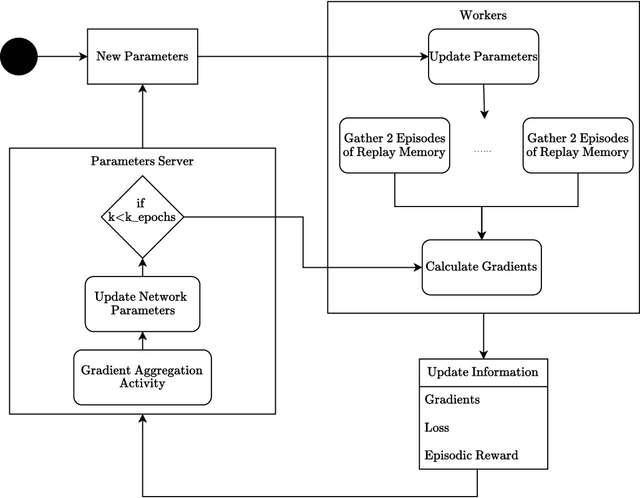



Abstract:This paper introduces two learning schemes for distributed agents in Reinforcement Learning (RL) environments, namely Reward-Weighted (R-Weighted) and Loss-Weighted (L-Weighted) gradient merger. The R/L weighted methods replace standard practices for training multiple agents, such as summing or averaging the gradients. The core of our methods is to scale the gradient of each actor based on how high the reward (for R-Weighted) or the loss (for L-Weighted) is compared to the other actors. During training, each agent operates in differently initialized versions of the same environment, which gives different gradients from different actors. In essence, the R-Weights and L-Weights of each agent inform the other agents of its potential, which again reports which environment should be prioritized for learning. This approach of distributed learning is possible because environments that yield higher rewards, or low losses, have more critical information than environments that yield lower rewards or higher losses. We empirically demonstrate that the R-Weighted methods work superior to the state-of-the-art in multiple RL environments.
Contrastive Transformer: Contrastive Learning Scheme with Transformer innate Patches
Mar 26, 2023Abstract:This paper presents Contrastive Transformer, a contrastive learning scheme using the Transformer innate patches. Contrastive Transformer enables existing contrastive learning techniques, often used for image classification, to benefit dense downstream prediction tasks such as semantic segmentation. The scheme performs supervised patch-level contrastive learning, selecting the patches based on the ground truth mask, subsequently used for hard-negative and hard-positive sampling. The scheme applies to all vision-transformer architectures, is easy to implement, and introduces minimal additional memory footprint. Additionally, the scheme removes the need for huge batch sizes, as each patch is treated as an image. We apply and test Contrastive Transformer for the case of aerial image segmentation, known for low-resolution data, large class imbalance, and similar semantic classes. We perform extensive experiments to show the efficacy of the Contrastive Transformer scheme on the ISPRS Potsdam aerial image segmentation dataset. Additionally, we show the generalizability of our scheme by applying it to multiple inherently different Transformer architectures. Ultimately, the results show a consistent increase in mean IoU across all classes.
CostNet: An End-to-End Framework for Goal-Directed Reinforcement Learning
Oct 03, 2022Abstract:Reinforcement Learning (RL) is a general framework concerned with an agent that seeks to maximize rewards in an environment. The learning typically happens through trial and error using explorative methods, such as epsilon-greedy. There are two approaches, model-based and model-free reinforcement learning, that show concrete results in several disciplines. Model-based RL learns a model of the environment for learning the policy while model-free approaches are fully explorative and exploitative without considering the underlying environment dynamics. Model-free RL works conceptually well in simulated environments, and empirical evidence suggests that trial and error lead to a near-optimal behavior with enough training. On the other hand, model-based RL aims to be sample efficient, and studies show that it requires far less training in the real environment for learning a good policy. A significant challenge with RL is that it relies on a well-defined reward function to work well for complex environments and such a reward function is challenging to define. Goal-Directed RL is an alternative method that learns an intrinsic reward function with emphasis on a few explored trajectories that reveals the path to the goal state. This paper introduces a novel reinforcement learning algorithm for predicting the distance between two states in a Markov Decision Process. The learned distance function works as an intrinsic reward that fuels the agent's learning. Using the distance-metric as a reward, we show that the algorithm performs comparably to model-free RL while having significantly better sample-efficiently in several test environments.
* 14 pages, 5 figures, In Proceedings of the International Conference on Innovative Techniques and Applications of Artificial Intelligence, SGAI2020
 Add to Chrome
Add to Chrome Add to Firefox
Add to Firefox Add to Edge
Add to Edge